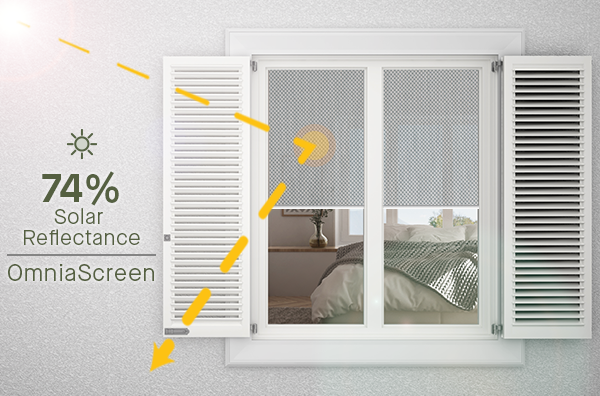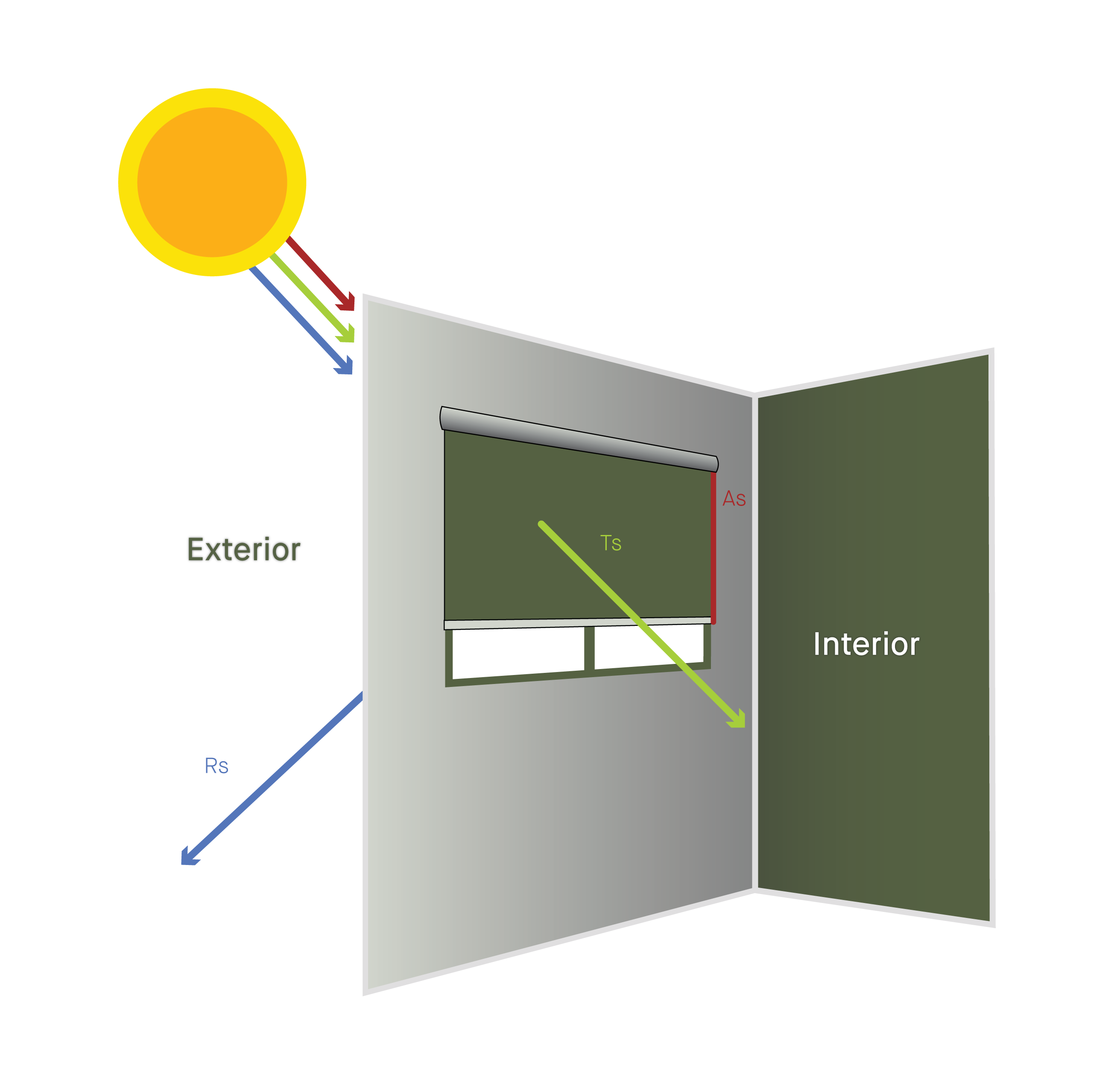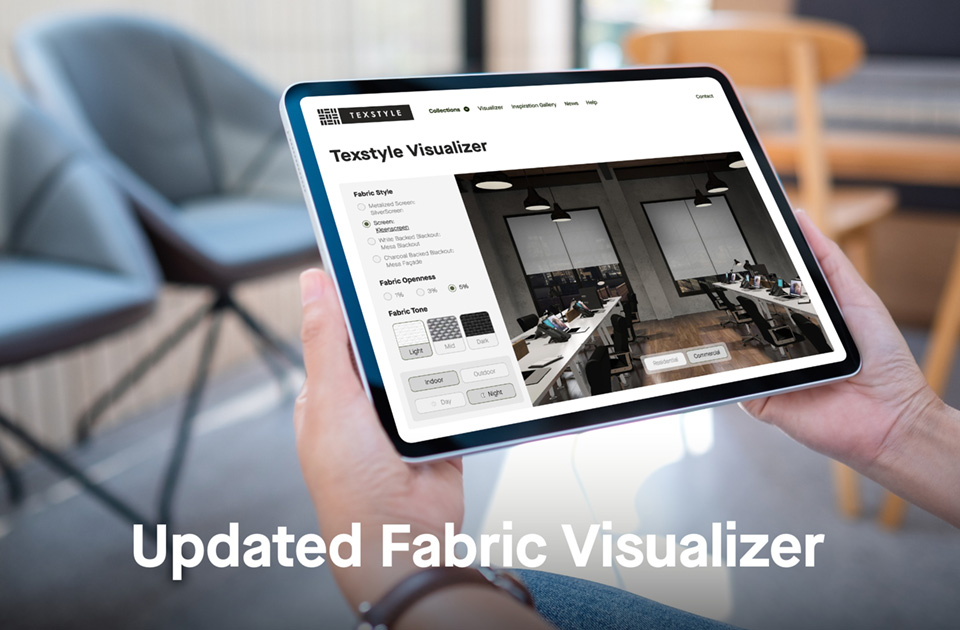
Why should I consider using a metalized solar screen fabric?
Traditional solar screens are a wise choice for window coverings due to their ability to allow light into a space while still blocking harmful UV rays. The performance of a solar screen is impacted by openness and color. At times, the color can impact shade performance in a negative way. Selecting a metalized solar screen assures the best performance from every color.
While solar screen fabrics are available in a wide variety of colors, this post will focus on the performance of white and black as the performance of other colors falls somewhere in between. White and black each have different strengths and weaknesses.
White shades are great for energy reflection but not so great for view through and glare. A high level of glare can cause visual discomfort and result in reduced productivity levels. Black shades create far less glare, making them excellent for light control and view through, but a high absorption rate and a low reflectance value can result in an increase in the temperature in the room. This can make room inhabitants uncomfortable and can increase the reliance on cooling units.
Metalized solar screens can give you the benefits of both light and dark colors in just one shade. The aluminum backing reflects the sun, keeping heat out and reducing glare. The advanced metallization process created by Verosol and used on Texstyle’s metalized high-performance fabrics results in the highest reflectance values in the market.
How do metalized shades work?
Here’s a quick explanation as to just how much the metalized backing can improve shade performance.
Solar protection is measured using both thermal and optical factors.
Thermal factors relate to the amount of thermal energy penetrating the fabric. Thermal factors are measured in percentages by Ts (solar transmission), Rs (solar reflectance), and As (solar absorption).
- Ts measures the proportion of solar energy that is transmitted through the fabric, making it into the room. This can impact visual comfort.
- Rs measures the proportion of solar energy that is reflected by the fabric, keeping it out of the room.
- As measures the proportion of solar energy that is absorbed by the fabric. This measurement can impact both glare and room temperature.
As these are percentages, the sum of all three measurements will always equal 100.

Optical factors relate to the amount of light that a fabric will let through. Tv (visible transmission) is the primary measurement and measures the portion of sunlight the eye can see.
Non-metalized versus metalized
Here are some examples of the performance of a traditional solar shade versus a metalized shade, using our most popular 3000 NET and OmniaScreen fabrics. OmniaScreen is the same as 3000 NET but with a metalized backing, making it a great choice for windows facing direct sunlight.
Below are the values for the measurements we discussed earlier.
Let us first look at 3000 NET 3% in White/White. The Ts value is on the higher side, meaning more transmission into the room, resulting in higher levels of glare. The Rs value is high, showing that most of the solar energy is reflected. The Tv value is high indicating a higher portion of visible sunlight in the room. This fabric has good thermal performance but would result in higher levels of glare and lower visual comfort.
OmniaScreen 3% in White/White, when compared with 3000 NET, has similar Rs and As values, but lower Ts and Tv values, both which tie to visual comfort. In this instance, the metalized backing maintains the thermal performance but greatly reduces the glare.
3000 NET 3% in Charcoal/Charcoal has good values for Ts, and Tv, meaning that visual comfort would be high. The As value is high which means that a high percentage of energy is going to be absorbed by the shade itself. In this case the high AS will reduce glare but may also lead to energy radiating into the room. The Rs value here is very low, meaning that next to no energy is being reflected back which will result in heat transfer to the room.
OmniaScreen 3% in Charcoal/Charcoal, when compared with 3000 NET, significantly improves the Rs value which means that more solar energy will be reflected. This is one of the primary benefits of a metalized fabric. When combined with a reduced As value, this increase in reflectance means that the temperature of the fabric (and therefore in the room) will not increase as much as with the traditional screen. In this instance, the metalized backing maintains the visual performance but greatly improves the thermal performance of the dark colored fabric.
While some people are concerned that a metalized shade will look like a mirror from the outside, this is certainly not the case. Because the yarns are round (not flat), they create a diffuse reflection, and the aluminum coating ends up looking like a light gray.
Summary
Improving the thermal performance of a traditional solar screen can result in reduced cooling costs, putting less stress on the HVAC system and ultimately reducing the building’s carbon footprint.
A metalized backing allows for the best attributes of light colors and the best attributes of dark colors to be combined. Additionally, the metalized backing allows you to choose any color you like to face the room while still providing a uniform view from the outside.
For more information on the benefits of a metalized shade and to see our full offering, contact your sales manager or email us at info@texstyle.com.
Click here to view the OmniaScreen 3% product page.


